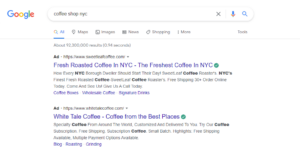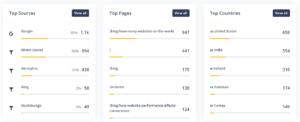What is Website Traffic?
Website traffic refers to the users that visit a Website. Each time a user arrives on one of your landing pages, it is counted as a visitor to your site.
These visits are often spoken of as sessions in Google Analytics.
Why it’s important to Track Website Traffic
Your website traffic is a good indicator of the overall success of your site. The higher the traffic, the more potential you have for conversions.
On the other hand, if your website’s traffic is low, you might want to focus more on your SEO efforts to try up the visitors to your website.
Keeping a close eye on the different metrics of website traffic will tell you what people are looking for on your pages and allow you to tailor your content to suit their needs.
Not paying attention to your website traffic could be likened to a shop owner not caring about the empty seats and deserted tables in his coffee shop.
If he doesn’t pick up on what prevents people from entering his shop, he could suffer great financial loss.
No patrons = No Sales
Key metrics to Track Website Traffic
When you think about measuring website traffic, there are a few essential metrics in website analytics you want to examine closely. These metrics will also tell you much about user behavior or how people interact with your pages.
- Total visits
Sessions or visits are metrics used to estimate the total number of times someone visits your website and navigates around it.
These are critical metrics, especially in digital marketing. That’s because they are used along with the conversion rate to measure an online store’s performance.
If you use a Google Analytics Account to analyze your website traffic, this metric will be tracked by default and displayed on the dashboard, as seen in the screenshot below.

GA Dashboard
Although the metric appears as default, it can also be adjusted when navigating to Audience > Overview. That will allow users to compare Sessions with other metrics, such as the bounce rate.
Google Analytics logs a session from the moment a user interacts with a website and stops counting the session after 30 minutes of inactivity with the website.
- Pages per visit
This is a good metric to gauge how engaging your website is to visitors.
When a visitor arrives on a landing page, it could be seen as only the first step of the desired response.
Abralytics have a nice way of displaying page views using a line chart, as seen below.

Abralytics Demo
Users can see the Total Page Views in a separate tab, or view a breakdown of page views by the pre-determined time, whether by day, week, or month.
Why is it important to know how many pages are viewed each visit?
Well, you want conversions, don’t you?
You want people to scroll through various pages of your product line, not just visit one page and then move on to a different website.
Therefore, if you see that the pages per visit metric is too low, you could adjust the way they navigate through your site. Perhaps building internal links would help with the conversion rates.
The more pages visited per session, the higher the probability of generating revenue.
- Average visit duration
DataBox says a good average session duration is anything above three minutes. (2)
This metric will tell how long, on average, your visitors are staying on your website. You can’t improve average visit duration with catchy titles or marketing campaigns.
To improve your visit duration metric, you’ll need to ensure that your content grabs enough attention the keep users interested if you want them to stay on a web page for longer.
There’s also something to say about the format of your content. Short paragraphs make it easier for site visitors to stay engaged, while interesting photos break up the monotony of longer pieces.
You could also add videos to your pages that people find interesting and informative to watch. You can also toggle your Analytics report to display how much time visitors spend on each page.
- Bounce rate
Bounce rate refers to the percentage of visitors who leave the site after viewing only one page.
This metric is only important if you have a site that requires visitors to move from one page to the next and not if your website consists of one scrollable page.
Bounce rates could indicate that visitors aren’t finding the information they are looking for or find the site frustrating to use.
So, what is a reasonable bounce rate for my site?
Semrush addressed this question in a recent blog post, citing:
“A bounce rate of 56% to 70% is on the high side, although there could be a good reason for this, and 41% to 55% would be considered an average bounce rate. An optimal bounce rate would be in the 26% to 40% range.” (4)
If you want to improve the bounce rate on your site, you should ensure that the pages people visit meet their expectations. When a user visits a page and finds what they’re looking for, they’ll be more likely to navigate through your site rather than click away.
By monitoring the bounce rate metric, we can get a good idea of the user behavior, identifying what people are interested in or not.
- Traffic sources
This metric measures which sources are driving traffic to your website.
Different channels fall under this metric, namely:
Direct traffic: These are visitors to your site that arrive by typing your website directly into their browser
Referral traffic: Visitors that visit your website from another website
Organic Search traffic: Visitors that click on your website by searching a keyword in a search engine (Google, Bing, Yahoo, etc.)
Paid search traffic: Visitors that visit your website through a dedicated marketing campaign like Google Adwords or click on a link with tracking parameters (UTM or tracking code).
Email traffic: Visitors that visit your website by clicking on an email marketing campaigns
Social traffic: Visitors that visit your website from social media sites
By understanding where the most traffic comes from, you’ll be able to see if your time and effort spent on your marketing strategy and other campaigns are worth it.
You’ll also better understand where you need to focus your attention to optimize your traffic flow.
How can I increase my Website Traffic?
How much traffic you’re able to generate is often directly impacted by your content marketing efforts and advertising campaigns.
For example, to increase foot traffic into a coffee shop, the owner would need to make sure that passers-by would want to stop there.
Does it look inviting from the outside?
Is the coffee really all that?
Do the advertising boards effectively entice customers into the place?

Source: Pexels
If the general public knows about the delicious Cappuccinos your barista can deliver, time and again, there will always be a line of customers waiting and full till.
Take a similar approach to your Website Traffic, and ask yourself:
Does my website look pleasing to the eye?
Is my content really all that, and does it add value to potential visitors?
Are my marketing efforts directed at the right audience?
By creating excellent content that is visually pleasing, you will give your website visitors reason to want to return to your site. And more than that, they will likely feel the need to share the experience with others.
As the word spreads, the traffic coming in will increase.
Sometimes though, marketing efforts aren’t enough.
You need to consider two mainstream options to gain more website traffic. Paid search and Organic traffic resulting from SEO efforts.
Paid search
If you’re looking for quick results, consider paid search.
Sure, it’s more costly in the long run as you’re paying for Google to add you right at the top of the SERP, but just a short stint at the top could have long-lasting effects on your website traffic.
When a result is featured at the top of the results page because of paid search, it will feature the word “Ad” before displaying the website.

The above is an example of this. Those coffee shops didn’t gain the top spot because of SEO practices; they paid to be placed in that position.
Organic search results might take longer, but the cost is almost a lot less than paid results. It boils down to what you can afford.
Gaining Organic traffic through the SEO approach

Target Keywords
Keywords are the words or phrases people punch into Search Engines when looking for a product, service, or an answer to a query.
There are many free Keyword Research Tools out there that will help you identify the phrases people are searching for. (1)
Try to rank high for certain niche-specific keywords, especially long tail keywords.
Here’s a good description of the term “long tail keyword”
“A long tail keyword is a phrase that is generally made from three to five words. Since these keywords are more specific than generic terms, they allow you to target niche demographics. These keywords are also less competitive than generic keywords because they are designed to better reflect how people make queries. With long tail keywords, you are able to attract more high-quality traffic to your website, which is more likely to lead to conversions.” (3)
Gain Backlinks
Backlinks have long been a vital part of SEO strategies. If you can gain high-quality backlinks to your website, you show Google that other Website owners are taking note of your content.
This, in turn, motivates google to place you higher in the SERP results. The higher your page ranks, the more likely you’ll gain organic traffic.
Gaining links by yourself could be pretty tricky, so try using an SEO strategist or link-building professional that can offer this service. (5)
Add Social Share Buttons
This is an excellent way of attracting more traffic to your site. Consider it a proactive marketing approach.

Source: Pexels
Well-placed social share buttons will prompt website visitors to share what they like on social media platforms, increasing your visibility across different traffic funnels.
Customize your Reports
Any good web analytics tool will allow you to customize your reports and dashboards, helping you keep your finger on the pulse when looking at traffic reporting.
Here’s another example from Abralytics reporting.

Abralytics Demo
When you toggle your reports to show you the most important metrics, you’ll be quicker to make the needed adjustments.
Abralytics’ Top Sources infographic lets you see which traffic sources funnel brings in the most visitors to your website.
The Top Pages resource helps you visualize which one of your pages is performing the best and which needs to be improved.
The Top Countries traffic data allows you to understand how your website is being received and interacted with from different geolocations.
So make sure you fully utilize your website analytics tools capability and customize your reports to suit your needs.
Reasons for low Website Traffic.

Source: Pexels
There are many reasons for slow website traffic. And addressing all the possible issues might seem highly overwhelming.
But a good starting point is to address the following three issues, as they are easy to check.
- Slow Page Speed
Research has shown that the time your website takes to load affects your conversion rate.
Think about it. Have you ever waited for 30 seconds for a website to load? Me neither.
So, take a moment to think about your user experience and make the necessary adjustments to keep your visitors happy.
Some of these adjustments could include the following:
- Optimizing images and video
Images and videos take up a significant amount of a page’s overall size. So make sure that there aren’t too many images and videos trying to load on any given page, as this may cause pages to slow down and users to click away.
- Leveraging a caching and page speed plugin
A cached page delivers a static HTML version of a specific page to avoid time-consuming queries to your server. Cached pages thus load much quicker.
Page speed plug-ins also help to address page speed optimization, taking away a lot of the load speed frustration of users.
- Upgrading Your Web Hosting package
While using an inexpensive, shared (or grid) hosting platform can be tempting, investing in a high-performing VPS, managed, or dedicated web hosting platform should be a priority if you wish to address load speeds once and for all.
These packages often use much faster technology stacks, as well as feature dedicated resources and a host of important options to fine-tune your server.
- Outdated Information
When was the last time you checked the facts in your blog section?
If you’re quoting outdated sources and studies, Google will be sure to pick up that you’re no longer adding value to your website visitors. And before you know it, you’ll be slipping down the SERP results.
So take the time to ensure your content is up to date.
Search other websites in the same niche and check their blog out. Ensure that the content you deliver is as or more up-to-date.
- Bad Design
In the digital world, there’s nothing worse than clicking on a link only to be greeted with an ugly website that’s difficult to navigate.
When designing your website, keep the user experience in mind. People need to be greeted by professional landing pages that make it easy to find what they need without being bombarded by ads and spammy links popping up everywhere.
So, think about what will make unique visitors return, and design your layout around that.
In Conclusion
By measuring the user behavior of your website traffic, you can make needed adjustments and tweaks that will secure the longevity of your website’s success. And it isn’t that difficult to do.
Make use of a good platform to track your website metrics, such as Google Analytics or Abralytics. Regularly checking the monthly traffic report will help you keep your finger on the pulse at all times.
Sources:
4 – What is a Good Bounce Rate?





